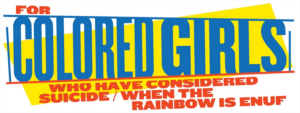Review Roundup: The Public Theater's FOR COLORED GIRLS... - What Did the Critics Think?

The Public Theater presents a major New York revival of FOR COLORED GIRLS WHO HAVE CONSIDERED SUICIDE/WHEN THE RAINBOW IS ENUF, written by legendary playwright/poet Ntozake Shange.
Directed by Obie Award winner Leah C. Gardiner with choreography by Camille A. Brown, FOR COLORED GIRLS officially opened on Tuesday, October 22. This powerful revival has been extended one week and will now run through Sunday, November 24.
The complete cast of FOR COLORED GIRLS WHO HAVE CONSIDERED SUICIDE/WHEN THE RAINBOW IS ENUF features Celia Chevalier (Lady in Brown), Danaya Esperanza (Lady in Orange), Jayme Lawson (Lady in Red), Adrienne C. Moore (Lady in Yellow), Okwui Okpokwasili (Lady in Green), and Alexandria Wailes (Lady in Purple), with Sasha Allen joining the company as Lady in Blue, replacing the previously announced Jocelyn Bioh who withdrew due to scheduling conflicts.
Let's see what the critics are saying...
Tim Teeman, The Daily Beast: As beautifully designed in a kind of disco-era round (by Myung Hee Cho), choreographed by Camille A. Brown, set to music (Deah Love Harriott following Martha Redbone's original music), and directed by Leah C. Gardiner, this is an illuminating and emotional coming together. While one (or a number of women) speaks, the others listen. The stage feels as fluid as the narratives. At the outset, while introducing where they are from, the Lady in Brown makes clear that what we are about to hear is about "colored girls who have considered suicide / but moved to the ends of their own rainbows."
Melissa Rose Bernardo, New York Stage Review: The most wrenching tale-the violent saga of Crystal, her babies, and Beau Willie Brown-certainly belongs to Lady in Red (Jayme Lawson); it also qualifies as perhaps the only part of Shange's play that translated well to Tyler Perry's 2010 film version, where he attempted to connect all the monologues into something resembling a narrative. But For Colored Girls' most stirring moments are its most celebratory: "my love is too delicate to have thrown back on my face," says Lady in Yellow (Adrienne C. Moore). Echoes Lady in Brown (Celia Chevalier): "my love is too beautiful to have thrown back on my face." And so on. "Delicate." "Beautiful." "Sanctified." "Magic." "Saturday nite." "Complicated." "Music." Speaking of music-cue the music. And the dancing-which is delicate, beautiful...and magic.
David Finkle, New York Stage Review: For 90 explosive minutes, the Ladies exchange Shange's free-verse lines with each other. They recite what are tantamount to arias (Lady in Blue Allen often sings hers), often while continuing to move as directed by Leah C. Gardiner and as choreographed by Camille A. Brown, who within the last year has distinguished herself with work on, to name a few, Choir Boy, Much Ado About Nothing and Porgy and Bess. Wearing Toni-Leslie James' costumes that feature multiple faces dotting monotone outfits, the women dance before they speak. The introductory activity is a virtual dance overture. During it, Brown alludes to familiar childhood preoccupations like hand-clapping games and Double Dutch rope jumping. The effect is thrilling, especially in the area set designer Myung Hee Cho has created-with audience members seated around it-that suggests a mirrored ballroom. A ballroom? With disco balls? Just wait.
Ben Brantley, The New York Times: But what's most striking about this incarnation, which is choreographed by Camille A. Brown, is its pervasive sense of women talking to - and being deeply invested in - one another, as if in an eternal support group. It's a sensibility that starts with its circular stage (Myung Hee Cho did the set, lighting is by Jiyoun Chang), which seems to exert a centripetal force, repeatedly pulling the performers into a single huddle. Not that the form of the individual monologues has been jettisoned. But while I remember "Colored Girls" as a series of vivid star turns, this version feels like an endlessly fluid collaboration. Some of the separate pieces have been divided, so that more than one person speaks them - or in the case of the balletically graceful deaf actress Alexandria Wailes, signs them.
Naveen Kumar, Time Out New York: The powerhouse ensemble includes rafter-splitting vocalist Sasha Allen (Lady in Blue), superbly expressive deaf actor Alexandria Wailes (Lady in Purple) and the razor-sharp Okwui Okpokwasili (Lady in Green). Toni-Leslie James's costumes are subtly printed with the faces of female relatives beloved by each performer, evoking a lineage of sisterhood that precedes Shange's time and promises to endure long afterward. The playwright died last year; on the evening I attended, a moment of silence was held to commemorate what would have been her 71st birthday. Her spirit seems to dance off every reflective surface, chasing down the receding dark with flickers of exquisite light.
Helen Shaw, Vulture: Shange's poetry is as keen as it was nearly a half-century ago, but it's this turning-towards-one-another quality that makes the show so rich. The poems are about the wounds of black womanhood: as the Lady in Yellow (Adrienne C. Moore) says, "bein alive & bein a woman & bein colored is a metaphysical dilemma / I havent conquered yet." The Ladies tell stories about joyful sexual awakening, but also about rape; they tell stories about confident, big-spirited women who cry themselves to sleep. Yet once the wounds are spoken about and danced about, they turn into healing balms. The Lady in Blue (Sasha Allen) sings some of her text-the newly composed music is by Martha Redbone-or the women dance together in Camille A. Brown's ecstatic choreography, and you watch them holding each other up. The audience has its experience, certainly, carried along by sound and courage and beauty. But this one is for the Colored Girls in the show: At every performance, they are the rainbow, and they are enough.
Reader Reviews
Videos

